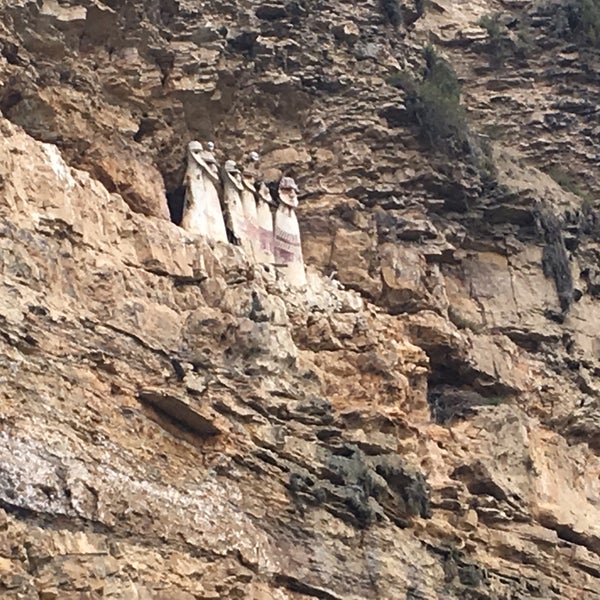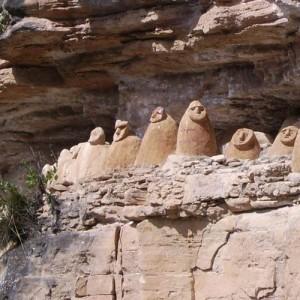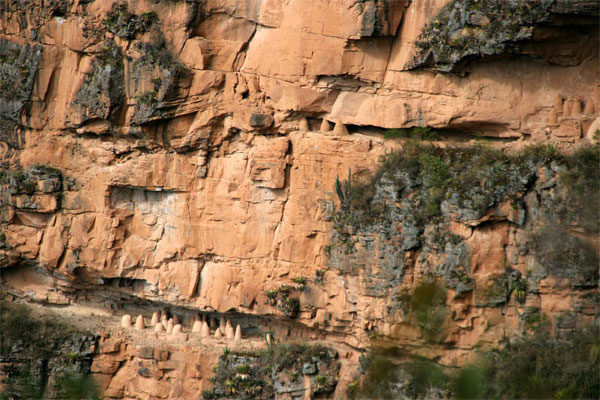Mystery humanoid coffin on offset cliffs in Peru
In Karajia, near the city of Chachapoyas, there are impressive tombs. Two-meter-high caskets of ingot bricks (clay bricks and dried) stand on the edge of a cliff, some of which still have traces of primitive painted motifs from centuries ago. The face on the coffin looked down majestically, as if dominating the lush green valley in senseless eyes.
According to many documents, the Chachapoya people are of Inca or Spanish origin. The amount of information about this mysterious tribe is very little. They are only known as the Chachapoya used by the Incas and the nickname "Cloud Warrior" emphasizes their friendly personality. Even after being conquered, groups of Chachapoya rebels fought for years.
Karajia is one of the archaeological sites that still keep traces of Chachapoya's lost civilization. About 60km from the city of Chachapoyas, this place has 7 coffins located on a steep cliff, more than 2,000 m from the ground. Burial sarcophagi of the Chachapoya tribe (known as "Purunmachos") here were announced in the world in 1984, following the discovery of archaeologist Federico Kauffmann.
About 30 miles from the northwestern city of Peru, Chachapoyas, under the valley of Utcubamba, there is a mysterious jagged cliff. The 1928 earthquake made the hills and mountains shake strongly, the rock fell down the river with impressive shapes.
These are humanoid statues about 7 feet (about 2.5 m) high with a wide jaw-shaped head that resembles that of Easter Island (Chile).
Shortly after the earthquake, scientists have found seven other coffins that have "overslept" for centuries here.
Six caskets with wide jaws, majestic face standing on high cliffs overlooking the valley. These rare remaining purunmachu sarcophagi have been carefully placed by the Chachapoya people in an almost inaccessible position halfway up the cliff.
Carbon analysis experiments were applied and the results showed that these sarcophagi date back to the period 1470 - a time when the inhabitants of Chachapoya were subject to Inca persecution. There is no specific document explaining the specific reason for this cremation. One can only surmise that they want the dead to rest and escape near the sky.
Each sarcophagus contains a mummy. According to the researchers, mummies of important people were buried in these coffins. The dead body is placed in the fetal position, then wrapped in a cocoon with a wild cane stem and tied with rope. This structure is further covered with clay and thick straw as the binder. The reason or purpose of this creepy ornament remains a mystery. These clay pieces have been around for over 600 years.
Burial of the dead in humanoid caskets and on the cliffs has been widely practiced by the Chachapoya people for centuries, throughout their history. Carefully placed in a nearly inaccessible position halfway through the cliff, these Purunmachos sarcophagi managed to escape the destruction of the invaders.
Each sarcophagus is painted white and decorated in yellow and red, helping to identify some details on the body. Some have horn caps, simulating deer antlers, while others have a mosaic of human skulls, believed to be a proud feat of the "cloud warrior".
On the western bank of the Utcubamba River many casks of various sizes were found. Ordinary people do not have access to these bizarre sarcophagi, only archaeologists currently managing research have access to them.







0 Comments